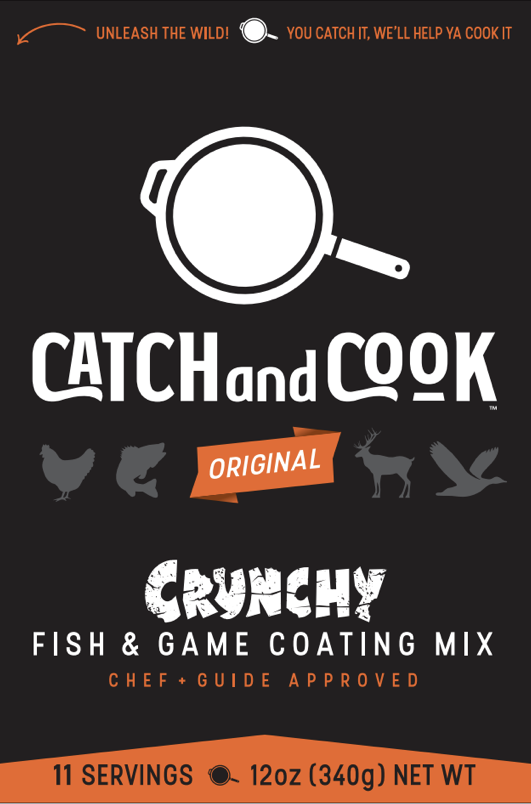A Culinary Adventure: Cooking Freshly Caught Walleye from a Day of Ice Fishing
There's nothing quite like the satisfaction of spending a successful day ice fishing and coming home with a haul of fresh walleye. The thrill of the catch combined with the anticipation of a delicious meal makes the experience truly memorable. One of the best ways to enjoy your fresh catch is by frying it to crispy perfection. In this blog post, we'll explore the art of cooking fresh walleye, including the ideal cooking oil for optimal frying temperature and the culinary benefits of using catch-and-cook wild game coatings as the breading.
The Art of Frying: Choosing the Right Cooking Oil
When it comes to frying fish, choosing the right cooking oil is essential. The oil should have a high smoke point to ensure that it doesn't break down at high temperatures, resulting in a cleaner and tastier end product. For frying walleye, oils like canola, vegetable, peanut, or sunflower oil are excellent choices due to their high smoke points. These oils can withstand the heat required for frying without imparting unwanted flavors to the fish.
Optimal Frying Temperature
Maintaining the right frying temperature is crucial for achieving that perfect crispy texture while ensuring the fish remains moist and tender on the inside. The ideal frying temperature for walleye is around 350°F (175°C). Using a kitchen thermometer to monitor the oil's temperature is a great way to ensure accuracy and consistent results.
Culinary Benefits of Catch-and-Cook Wild Game Coatings
Creating a flavorful and crispy coating for your freshly caught walleye is an integral part of the cooking process. While simple flour or cornmeal coatings work well, taking it a step further with catch-and-cook wild game coatings can elevate your dish to a whole new level. These coatings are specially designed to enhance the natural flavors of the fish while providing a satisfying crunch. Some culinary benefits of using these coatings include:
Flavor Infusion: Catch-and-cook coatings are often seasoned with a mix of herbs, spices, and even citrus zest, enhancing the fish's taste without overpowering it. This allows you to experience the delicate flavors of the walleye itself while enjoying an extra layer of deliciousness.
Texture and Appearance: The breading from catch-and-cook coatings creates a crispy and golden crust that not only adds a delightful crunch to each bite but also makes the dish visually appealing.
Minimal Oil Absorption: A well-formulated catch-and-cook coating can help minimize oil absorption during frying, resulting in a lighter and less greasy final product.
Customization: These coatings offer the flexibility to experiment with different flavors and textures, catering to your personal preferences and creating a unique culinary experience every time.
Cooking Steps
Clean and prepare the fresh walleye
If the “Fishy taste” is desired to be avoided, I like to pre soak my fillets in cold water with a table spoon of salt mixed in..
Dry Dredge the walleye fillets in the catch and cook coating, pressing gently to ensure even coverage.
Now in a 50/50 mixture of egg white and Milk take the dry dredge fillets and dip into the mix and wet dredge through the Catch and cook coating again (trust me this method adds a crispness that will make you the top chef at every fish fry!
Heat the chosen cooking oil in a deep skillet or frying pan to 350°F (175°C).
Carefully place the coated walleye fillets into the hot oil, ensuring not to overcrowd the pan.
Fry the fish for about 3-5 minutes per side or until the coating turns golden brown and the fish flakes easily.
Remove the fried walleye from the oil and place it on a paper towel-lined plate to drain excess oil.
Conclusion
Cooking freshly caught walleye from a successful day of ice fishing is a rewarding experience that can be elevated by using the right cooking oil and employing catch-and-cook wild game coatings. By choosing a high smoke point oil, maintaining the optimal frying temperature, and embracing the flavorful benefits of these coatings, you'll be able to create a mouthwatering dish that pays homage to your fishing skills and culinary creativity. So, the next time you venture out on an ice fishing expedition, remember that the ultimate reward awaits not only on the frozen lake but also in your kitchen.


